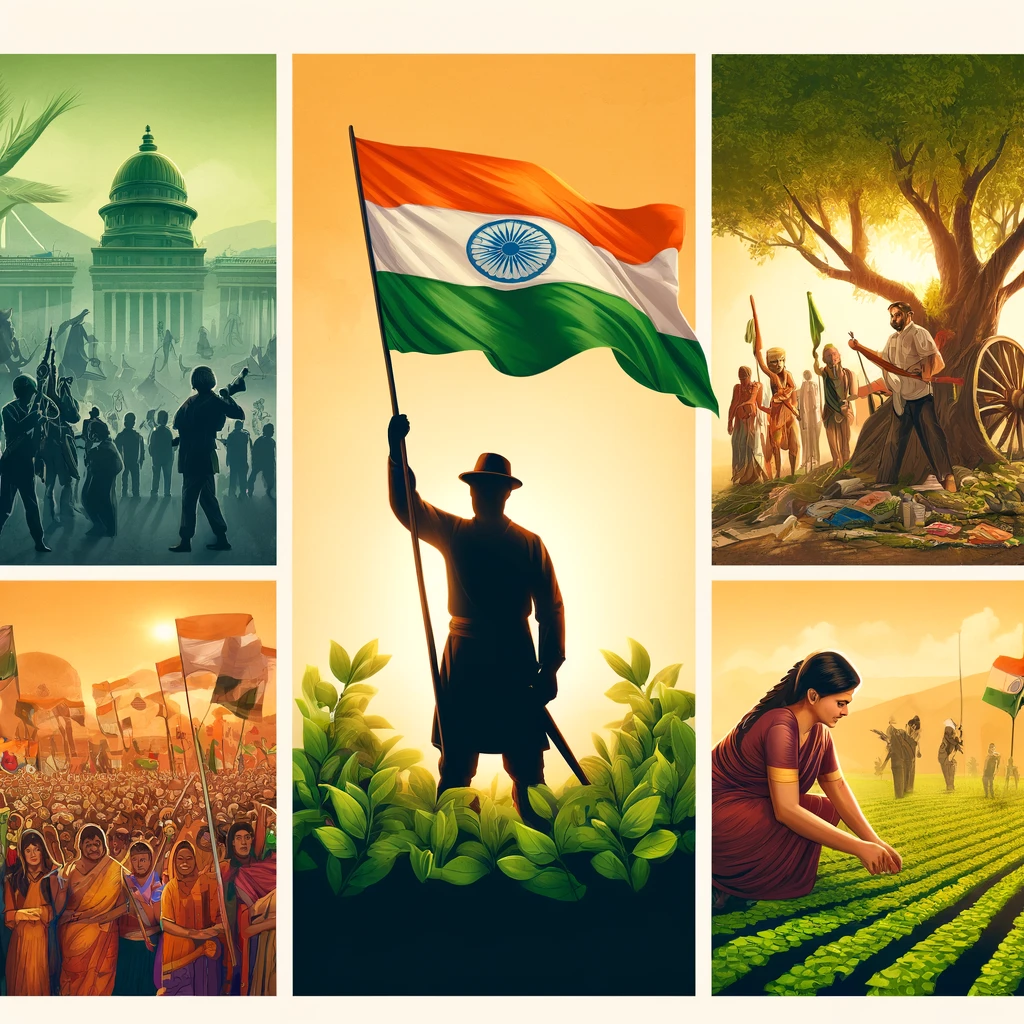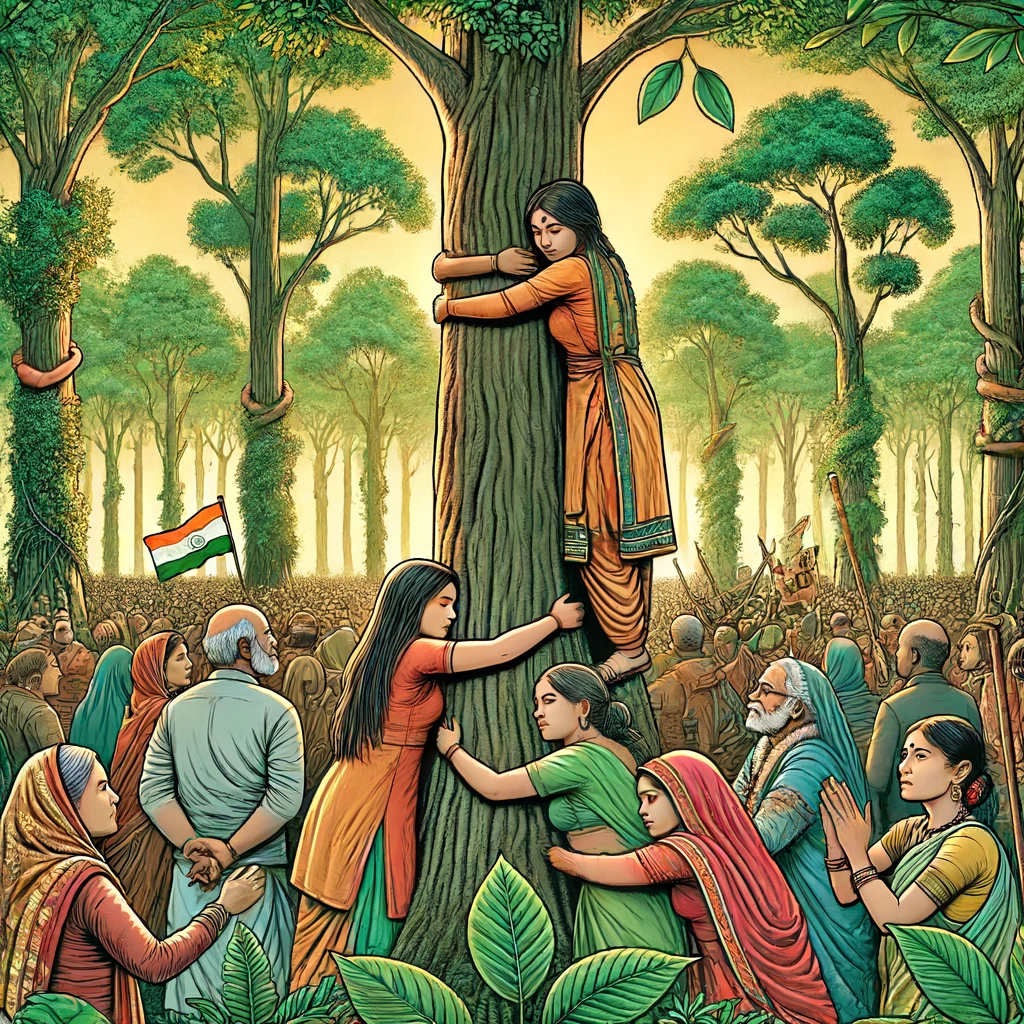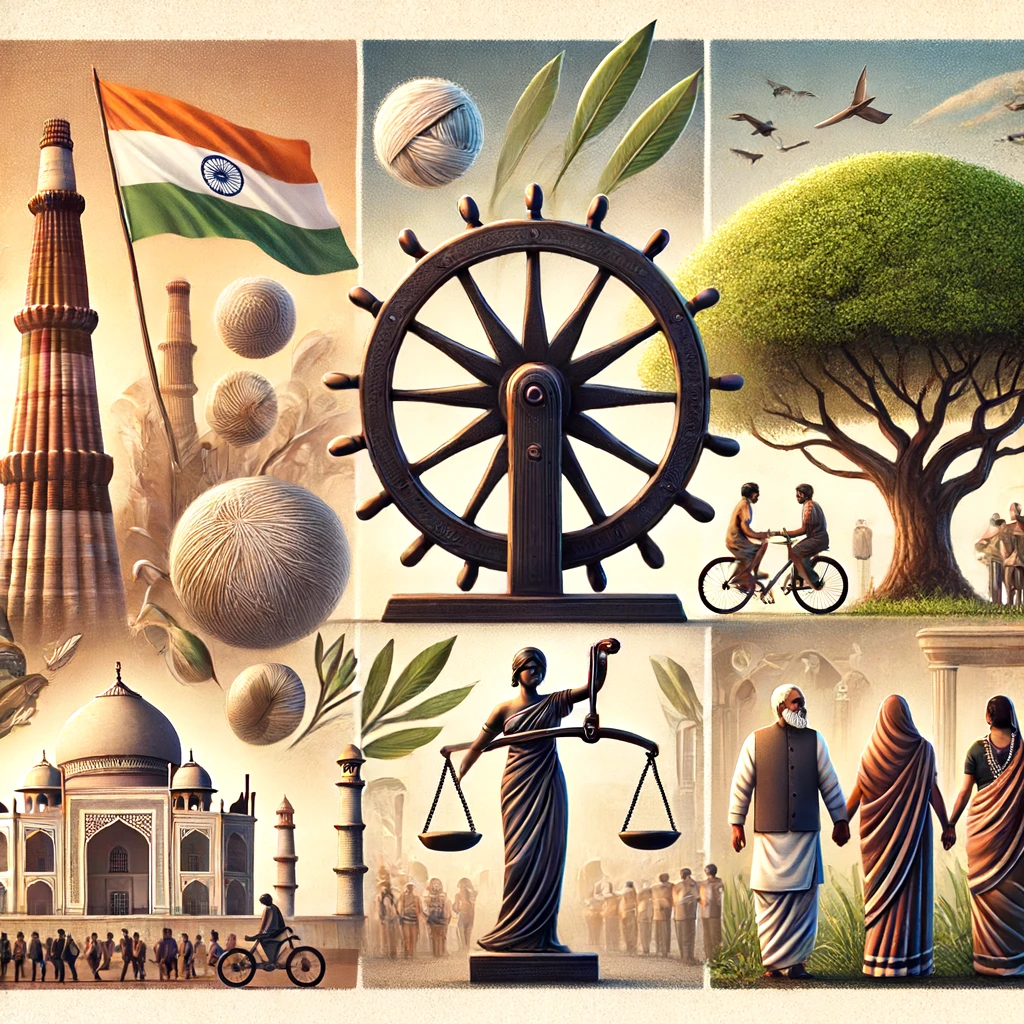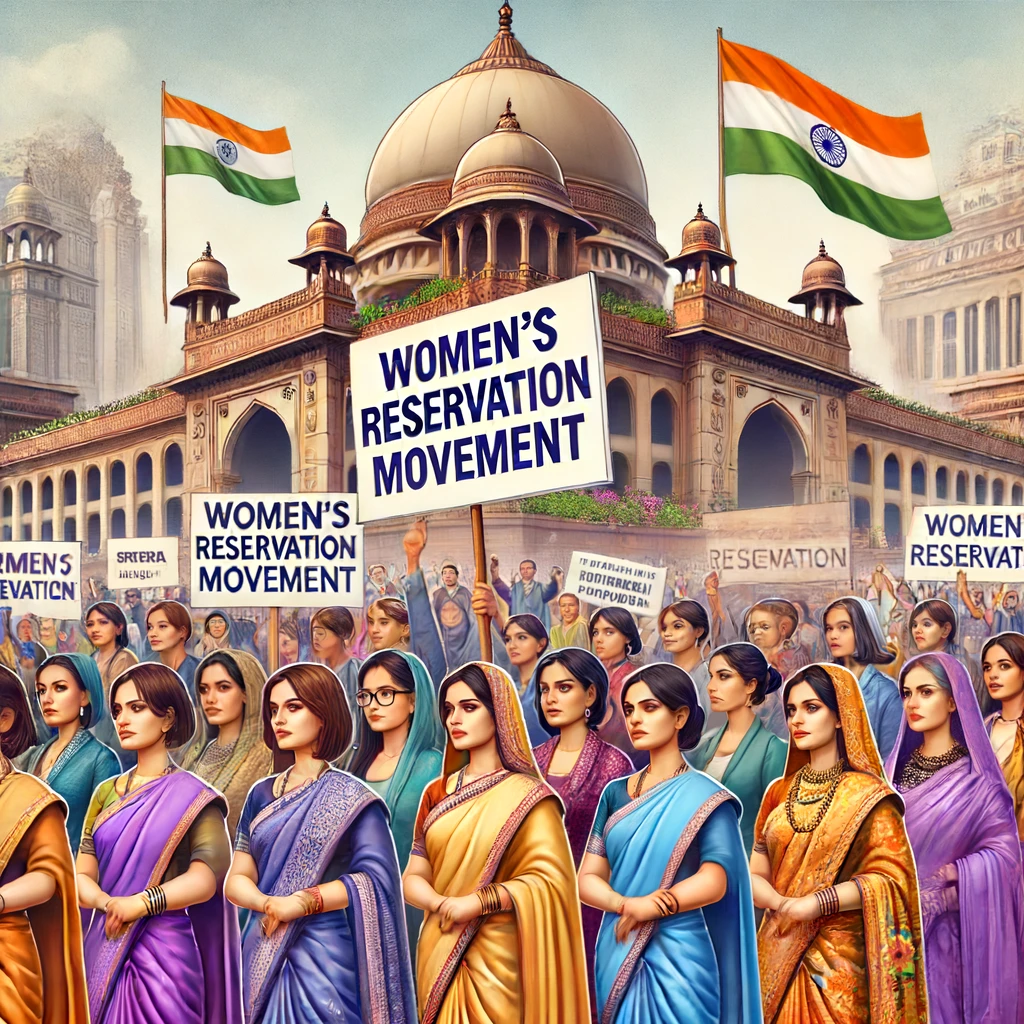Social Movements refer to groups of people attempting to change society, be it political, economic, or social. They come into existence as communities or individuals come together in response to some sort of injustice, inequality, or another issue. These movements have played an important role throughout history to bring about development and awareness, bridging the voices of the marginalized, and demanding reforms.
- Social Movements commonly seek to challenge existing power networks, ultimately fighting for justice, equality, and human rights.
- They can be local, national, or global as long as they encompass any issues of social, political, or environmental concerns.
- The Social Movements require pushing for systemic change through non-violent resistance and protest.

Environmental Movements
The environmental movements in India have played an important role in enlightening and voicing the consciousness of sustainable practices for the environment. To a large extent, such movements have greatly influenced environmental policies with numerous legislative benefits to local communities for the conservation of natural resources.

Chipko Movement
This is one of India’s most iconic environmental movements, dating back to the early 1970s in the Garhwal Himalayas of Uttarakhand. The locals, primarily women, adopted trees to stop contractors from felling them.
Key Figures
- Sunderlal Bahuguna: A legendary environmentalist who organized the Chipko Movement.
- Gaura Devi: Suggested the concept of women’s participation to save the trees.
Goals
- To prevent the destruction of forests.
- To raise awareness about the importance of sustainable environmental practices.
Outcomes
- The movement effectively brought to a standstill the ravage of the region due to deforestation.
- In consequence, it led to the policy of community-based management of forests.
- The Chipko Movement inspired similar movements in India to emphasize the call for environmental conservation.
Anti-Corruption Drives
Anti-corruption movements in India have also contributed a lot in addressing the widespread problem of corruption. Movements have led to the enactment of laws that can aim at better transparency and accountability in governance.
Anna Hazare-led Anti-Corruption Movement
In 2011, social activist Anna Hazare launched a hunger strike to demand the implementation of the Jan Lokpal Bill, which aimed to create an independent anti-corruption body.
Key Figures
- Anna Hazare: A veteran social activist who spearheaded the movement.
- Arvind Kejriwal: A key member of the movement who later founded the Aam Aadmi Party (AAP).
Goals
- To establish an independent body (Lokpal) to investigate graft cases.
- To make the offices in public more transparent and reduce grafts in them.
Outcomes
- The movement became very popular, and thus protests erupted in every nook and corner of the country.
- The Lokpal and Lokayuktas Act was eventually enacted in 2013 in the Indian parliament.
- The Movement also resulted in the emergence of the political party AAP dedicatedly to working towards the stoppage of corruption.
Impact on Policies
The movement catalyzed the enactment of the Lokpal and Lokayuktas Act, aimed at creating independent bodies to investigate and prosecute corruption cases, thus strengthening anti-corruption mechanisms in India.

Caste and Reservation Movements
Caste and reservation movements in India have arguably played a significant role in scuttling the deep-rooted caste system and hence, advocating for more rights for the unorganized sections of society.
Dalit Movement
Major global movements, including a Dalit movement, had some key milestones created in and through the actions of leaders such as Dr. B.R. Ambedkar.
Key Figures
- Dr. B.R. Ambedkar: A prominent Dalit leader who fought for the cause of the downtrodden and even drafted parts of the Indian Constitution, he grappled with the difficulties that people of today’s India are trying to face.
- Periyar E.V. Ramasamy: He was the founder of the Self-Respect Movement which campaigned for the rights of lower castes.
Goals
- It dreams of eliminating the caste system and work on social equity.
- It ensures reservation policies to uplift the marginalized section.
Outcomes
- It led to the inclusion of reservation policies in the Indian Constitution.
- It initiated significant social and economic changes that elevated the status of marginals within society.
- The Mandal Commission movements exemplify one of the active debates over the policy of reservation.
Impact on Policies
The Dalit and other caste-based movements have been instrumental in securing affirmative action policies, including reservations in education and employment, ensuring greater representation and opportunities for marginalized communities.
Women’s Rights Movements
Women’s rights movements in India have been pivotal in advocating for gender equality and challenging societal norms that discriminate against women. These movements have led to significant legal and social reforms.
Key Movements
- Women’s Reservation Movement: Advocates for the reservation of seats for women in legislative bodies.
- MeToo Movement: A recent movement that brought attention to issues of sexual harassment and assault.
Key Figures
- Savitribai Phule: A pioneer in women’s education and social reform.
- Aruna Roy: An activist for women’s rights and the Right to Information Act.
Goals
- To achieve gender equality and secure women’s rights.
- To address issues like gender-based violence, discrimination, and inequality.
Outcomes
- Legal reforms such as the Domestic Violence Act and the Sexual Harassment of Women at Workplace Act.
- Increased awareness and societal changes regarding women’s rights and gender equality.
- Significant strides in women’s participation in education, politics, and the workforce.
Impact on Policies
Women’s rights movements have led to the enactment of several laws aimed at protecting and promoting women’s rights, including the Prohibition of Child Marriage Act and the Maternity Benefit Act.

Labor and Trade Union Movements
Of course, labor and trade union movements are key issues in India: they form the core of efforts to protect workers’ rights and improve labor conditions. They have significantly altered the labor code of laws and policies.
Key Movements
- Textile Workers Strike (1982): A major strike by textile workers in Mumbai demanding better wages and working conditions.
- All India Trade Union Congress (AITUC): One of the oldest trade union federations advocating for workers’ rights.
Key Figures
- Dattopant Thengadi: Founder of the Bharatiya Mazdoor Sangh, a prominent trade union organization.
- George Fernandes: A labor leader who played a key role in the 1974 railway strike.
Goals
- To improve wages, working conditions, and job security for workers.
- To advocate for workers’ rights and social justice.
Outcomes
- The movements led to significant improvements in labor laws, including the introduction of the minimum wage and social security benefits.
- Trade unions have played a crucial role in protecting workers’ rights and advocating for fair labor practices.
Impact on Policies
Labor and trade union movements have played a pretty important role so that the labor law gets enacted and in that way, such acts are done and formulated within the country which include the Industrial Disputes Act and also the Minimum Wages Act.
Conclusion
Major social movements in India have played the key drivers for radical socio-economic and political changes. From environmental conservations to fighting corruption, battling caste inequalities, women’s rights, and labor reform legislation among many others; all these have been pegged by major movements in the development of policies and societal values in the country.
| Major Social Movements in India Notes |
| 1. The Brahmo Samaj movement, founded by Raja Ram Mohan Roy in 1828, aimed to reform Hinduism by promoting monotheism and rejecting caste and idol worship. 2. Arya Samaj, founded by Swami Dayananda Saraswati in 1875, focused on reviving Vedic traditions and rejecting superstitions, untouchability, and idol worship. 3. The Satya Shodhak Samaj, initiated by Jyotirao Phule in 1873, aimed to uplift the lower castes and women by advocating education and social equality. 4. The Non-Cooperation Movement of 1920, led by Mahatma Gandhi, was a mass civil disobedience movement aimed at gaining independence from British rule through non-violent means. 5. The Quit India Movement in 1942, also led by Gandhi, was a significant civil disobedience campaign demanding the immediate end of British rule in India. 6. The Self-Respect Movement, led by Periyar E.V. Ramasamy in Tamil Nadu, challenged Brahmanical dominance and worked for the social equality of lower castes. 7. Chipko Movement of the 1970s was a grassroots environmental movement led by rural women in Uttarakhand, focused on preventing deforestation and preserving the local ecology. 8. The Narmada Bachao Andolan, initiated in the 1980s by Medha Patkar, aimed to protect the rights of tribal communities displaced by the construction of large dams on the Narmada River. |


